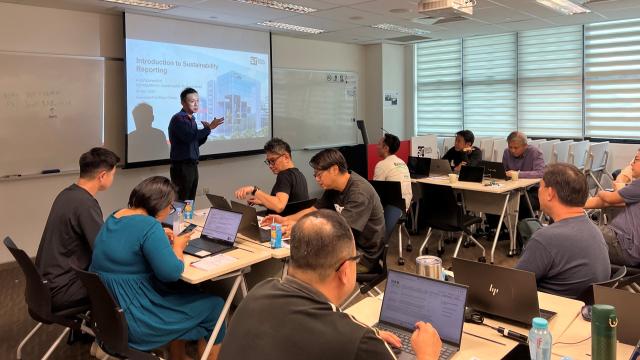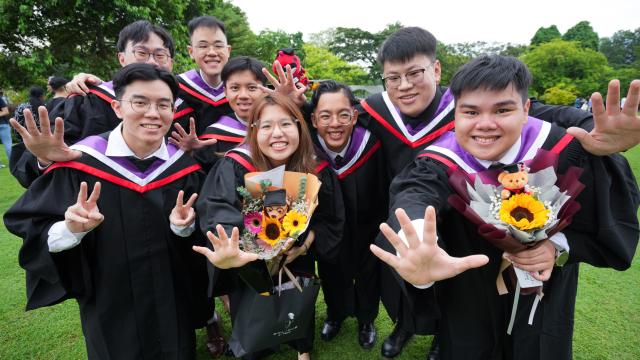During their six-month IWSP at a global semiconductor company, engineering students Andreas, Kee Chuan and Zhang Xu got a taste of the working world.
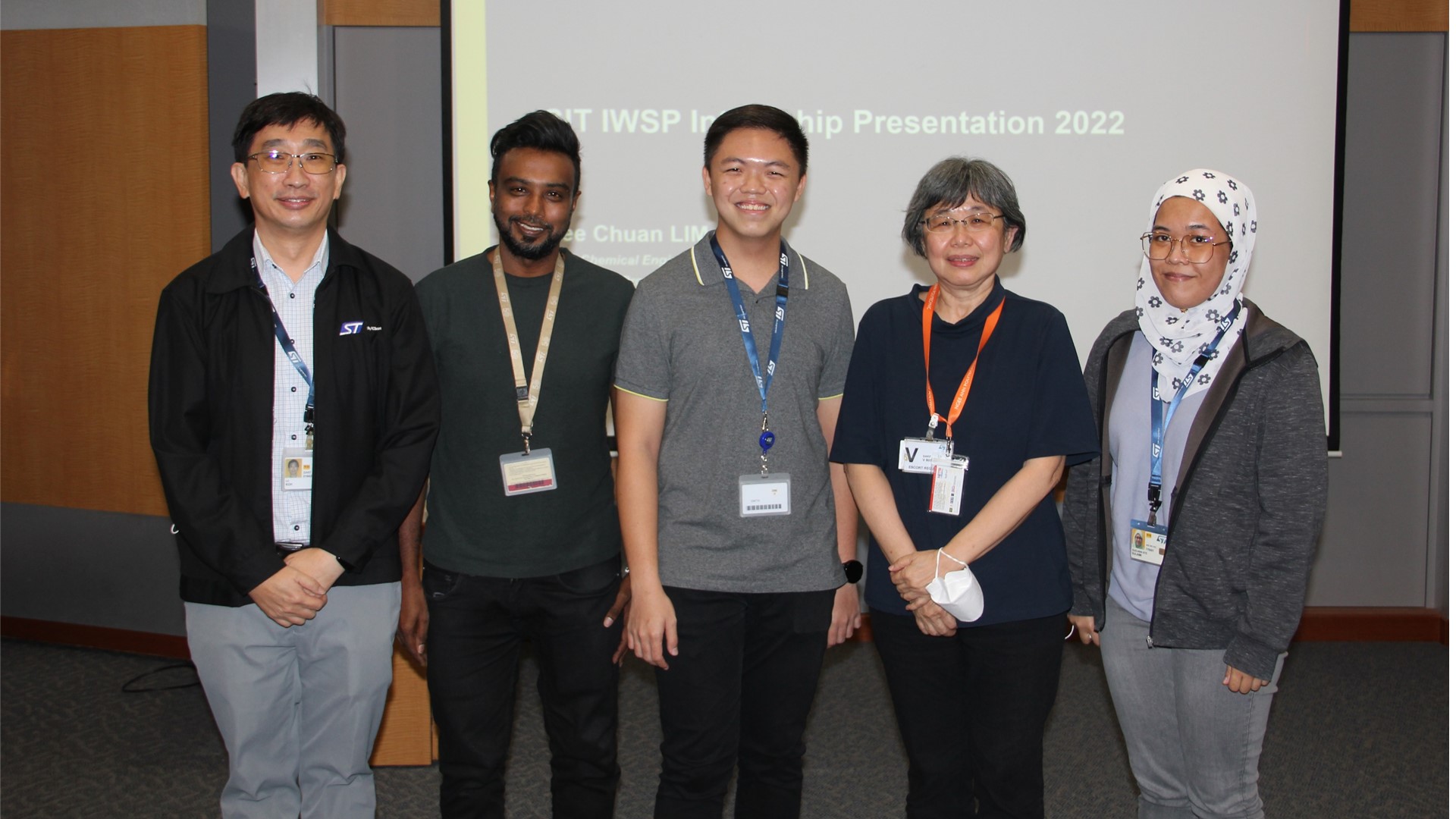
Chemical Engineering undergraduate Lim Kee Chuan (centre) with his Academic Supervisor Dr Kew Hong Chew (second from right) and STMicroelectronics colleagues, at STMicroelectronics where Kee Chuan gave a presentation on his IWSP experience. (Photo: Lim Kee Chuan)
It’s not every day an intern gets to leave his mark on a company; but during Lim Kee Chuan’s stint at STMicroelectronics, he did just that. The 25-year-old Chemical Engineering student was based at STMicroelectronics’ facility in Ang Mo Kio for six months as a process engineer. He not only learned on the job, but also helped the company save costs after improving one of its processes.
Microchips, or chips, are the mainstay of STMicroelectronics and an important part of many electric devices we use today, from smartphones to cars to washing machines. Chips can be fabricated from slices of silicon known as wafers. Wafers go through a series of processes, one of which is resist-stripping, where a machine removes unwanted layers from a wafer’s surface as it undergoes the wafer fabrication process.
Kee Chuan and his colleagues observed that during resist stripping, a specific portion of the wafers was not properly stripped away, and the wafer yield was affected.
After making adjustments to the resist stripping recipe – that is the instructions given to the machine -- Kee Chuan and his colleagues were able to recover more chips for further downstream processing.
“Last time, the main bulk of resist stripping was based on a specific rotation speed. We improved it by optimising the speed cycles. With the help of my mentor, we resolved the problem and significantly improved the wafer yield,” said Kee Chuan, whose tasks included running tests for equipment and troubleshooting problems.
The new recipe became the official recipe for those machines. Kee Chuan, who received the company’s “Say Thanks and Recognize (STAR)” recognition for his good work, was thrilled.
“I had been told that sometimes the projects we work on may not be something we see to completion – so it was great to be able to see this implemented, and also save costs for the company,” he added.
He was one of 26 engineering students from SIT, who did their work attachments at the semiconductor company from July 2022 to January 2023. This was the first time STMicroelectronics had partnered SIT for the university’s signature Integrated Work Study Programme (IWSP).
“The managers and supervisors were very welcoming; they regarded us more as fresh-graduate engineers than as interns,” said Kee Chuan.
Wafers and Recipes
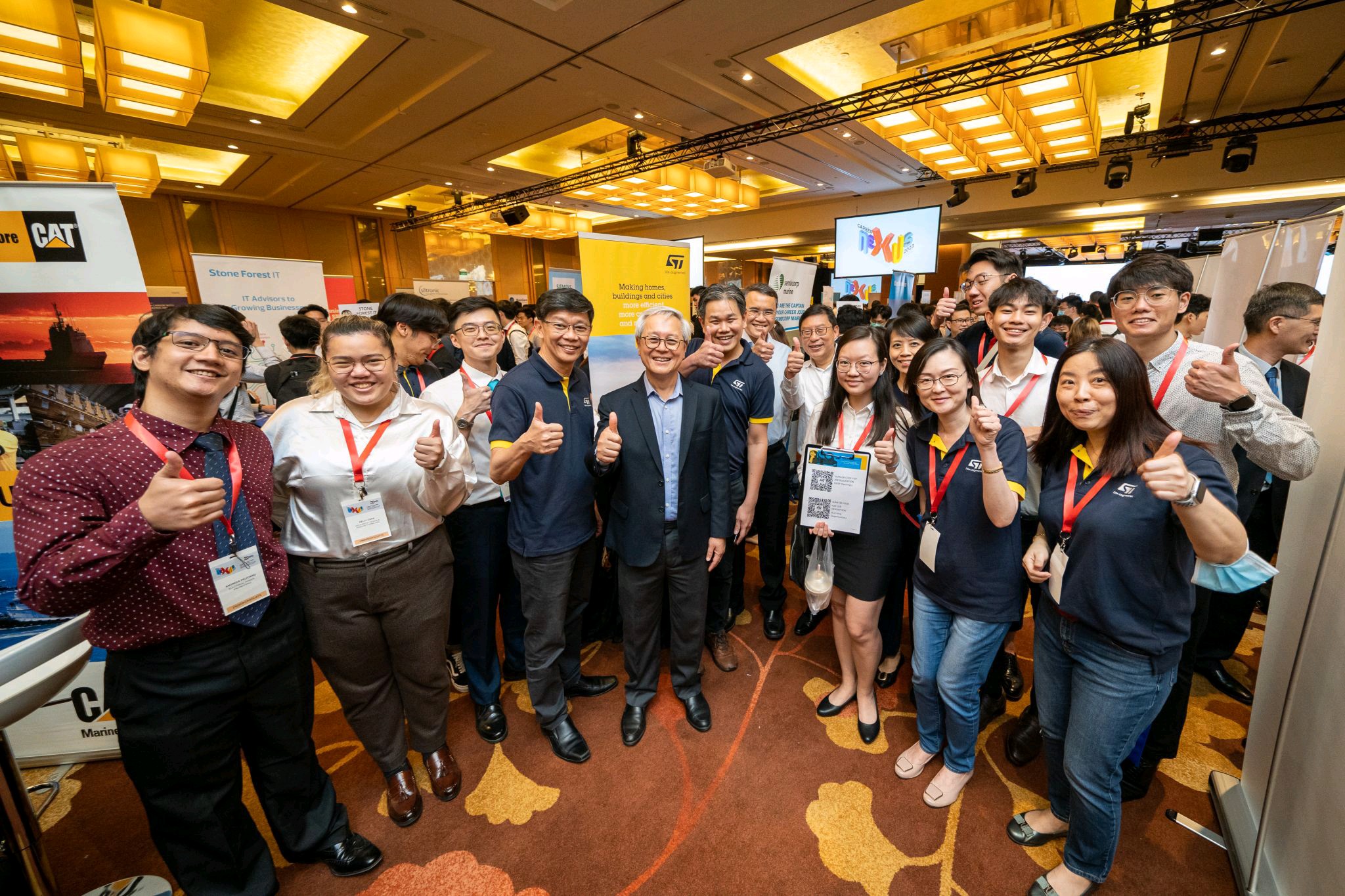
Electrical Power Engineering undergraduate Andreas Victor Feliciano (extreme left) with SIT and STMicroelectronics staff during Career Nexus 2023. (SIT Photo: Keng Photography/Keng Tan)
Third-year Electrical Power Engineering undergraduate Andreas Victor Feliciano also got a real taste of the industry, when he did his IWSP at STMicroelectronics.
As a device engineer at STMicroelectronics, he analysed the electrical data of fabricated wafers to assess if they met requirements and wrote qualification reports.
“I didn’t pay much attention to microchips before, but after working in the industry, they became more interesting to me. I became hungrier to learn new things,” said the 26-year-old, who finished his stint in January, but returns to STMicroelectronics every week for his final-year project on process and electrical yield improvement.
One challenge the IWSP students faced was getting up to speed with industry knowledge and knowing where and how to seek help. Andreas filled this gap by poring over documents and reports. Meanwhile, Kee Chuan had to unlearn old habits of being overly self-dependent when it comes to learning and asking for help when he needed to, rather than trying to figure it all out by himself.
Fellow IWSP student, Thian Zhang Xu, provided manufacturing line support as a process engineer at the diffusion department, where wafers are oxidised in furnaces. Being new to the semiconductor industry, he faced difficulty with technical jargon and industry concepts.
Engineers, Not Interns
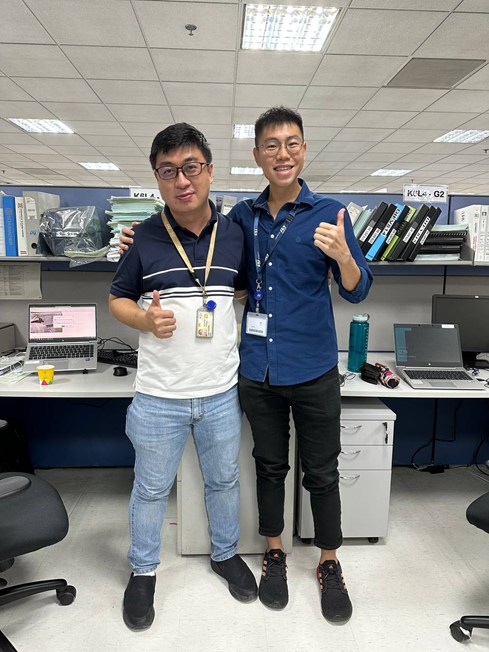
Thian Zhang Xu (right) with his industrial supervisor, Ang Yong Cheong. (Photo: Thian Zhang Xu)
However, the 25-year-old Mechanical Design and Manufacturing Engineering undergraduate hit his stride soon enough. As each tool uses multiple recipes to identify the processing steps and conditions required for different products, Zhang Xu helped to manage the grouping of tool recipes to facilitate a mass fine-tuning study. He also managed to configure the corrective maintenance control system using the checklists and guidelines for certain tool groups, which engineers can now use in the system.
A piece of advice from SIT’s Centre for Career Readiness stuck with the third-year Mechanical Design and Manufacturing Engineering undergraduate. “You should not see yourself as an intern. You should see yourself as someone who’s there to contribute and have the mindset of a full-time employee so you can make the best of this experience,” shared Zhang Xu.
Getting their hands dirty, after all, was what he and his peers were there for.
“It was so fun,” Andreas said. “There were tasks that I had trouble understanding, so I dived deeper into finding out why certain things were being done. Being able to see the relationship of certain processes and having that ‘eureka moment’ makes me enjoy the discovery process of being an engineer.”
Zhang Xu added that while they learnt a lot in the classroom, nothing beats the working world. “It is not until we are out in the field, participating and contributing, that we can truly learn what it means to be an engineer.”
Foo Kuo Yang, Human Resources Director at STMicroelectronics said, “Investing in the future of our community, through our strategic partnership with SIT, is very much in line with STMicroelectronics’s sustainability approach and talent strategy. We curated a unique immersive experience for our IWSP students. I am heartened that students like Andreas, Kee Chuan and Zhang Xu found value in working alongside STMicroelectronics employees, from contributing their knowledge to solving day-to-day real-life complex problems, to growing in their professional and personal development. This boosts our confidence that we have inculcated a stronger appreciation among our IWSP students of the meaningful work of the people behind technologies that contribute to a better, smarter and more sustainable world – be it in medical devices that save lives, electric vehicles that contribute to a greener environment, or communications devices that connect people.”
Watch how other SIT students who also did their IWSP at STMicroelectronics are making an impact.















![[FA] SIT One SITizen Alumni Initiative_Web banner_1244px x 688px.jpg](/sites/default/files/2024-12/%5BFA%5D%20%20SIT%20One%20SITizen%20Alumni%20Initiative_Web%20banner_1244px%20x%20688px.jpg)

